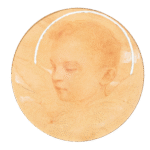Edgard Maxence
Biography
Edgard Maxence (1871–1954) was a French Symbolist painter renowned for his mystical, idealized compositions and mastery of color. Born into a prosperous bourgeois family in Nantes, the son of Henri Maxence and Estelle Boquien, he married Julienne Babin, linking him to the notable Babin-Béhic family, and became the stepfather of Roland Balaÿ.
Maxence began his artistic education under Egidio Sotta and Alexandre Chantron before entering the École des Beaux-Arts in Paris in 1891. Initially studying with Jules-Élie Delaunay, he transferred to Gustave Moreau’s class after Delaunay’s death. There, he was a contemporary of Henri Matisse, Albert Marquet, and Georges Rouault. Maxence developed a close relationship with Moreau, who supported his early recognition in competitions, including the 1894 prize for best expression in a head study. Although he never won the Prix de Rome, Maxence refined his style through the study and copying of old masters at the Louvre and developed a distinctive Symbolist vocabulary.
From 1895 to 1897, Maxence exhibited with the Rosicrucian Salon, solidifying his reputation for mysterious, medieval-inspired imagery. His works often integrate tempera, gold backgrounds, and wax-oil mixtures, emphasizing purity of line and a refined, almost ritualistic aesthetic. Notable works include L’Âme de la forêt, acquired by the Nantes museum, and Sérénité, held by the Musée de l’Abbaye Sainte-Croix in Poitiers. His oeuvre shows influences from Gustave Moreau and the Pre-Raphaelite movement, particularly in the depiction of female figures and interiorized, symbolic worlds.
He remained committed to his artistic ideals, producing portraits, landscapes, and Symbolist works with a focus on dreamlike, mystical atmospheres, largely indifferent to contemporary avant-garde developments. Maxence is today acknowledged as one of the last major practitioners of French Symbolism, combining technical precision with poetic and visionary content.

